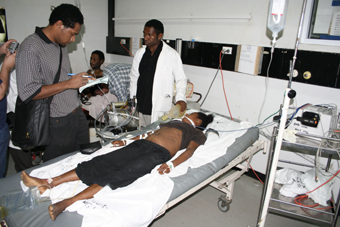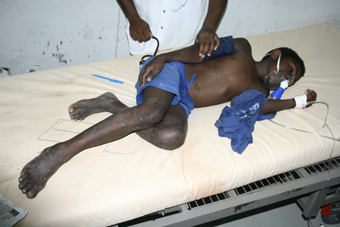

PAPUA NEW GUINEA SNAKEBITE RESEARCH PROJECT
A collaborative, capacity building project between the Australian Venom Research Unit, University of Papua New Guinea and PNG National Department of Health


Introduction
After having been a regular visitor to Papua New Guinea for several years, and having seen first-hand the consequences of snakebite in both rural areas, and in the urban environment of Port Moresby, I became passionately interested in contributing to an improvement in these outcomes. I had not long returned to University at the ripe old age of 34 (old enough to be called "Dad" by my classmates), and was itching to find a research topic that actually excited me. This was it.
With the encouragement of several people in PNG, and with advice from snakebite researchers like Professor David Warrell, a research proposal was prepared and submitted to the Department of Health in Port Moresby for ethical approval. Project approval was granted in early 2001 and subsequently ratified by the ethics committee at my University back in Australia. There was no funding offered and the costs of the project would have to be borne out of my own pocket, but I was simply too excited to be given this opportunity, to allow the small matter of "who's going to pay the bills?" to get in the road!
Lucky during those first few years I benefited enormously from the goodness of heart and deep pockets of two Port Moresby-based friends, Sir Philip and Lady Brenda Willmott-Sharp, who not only put a roof over my head during frequent visits to PNG, but also supplied many of the logistical needs that the project had, including space in their home for a multitude of venomous snakes and the rodents needed to feed them. Nothing was too difficult for Phil to sort out, and he became a frequent saviour when problems arose. Faced with limited income and high airfares between Australia and PNG, Phil got on the phone to his mate, Mick Curtain whose major construction company, Curtain Brothers (PNG) Pty Limited, just happened to fly its own King-Air aircraft backwards and forwards between Townsville (where I was living) and Port Moresby. For the next 18 months, if there was a seat available, Curtain Bros solved my travel problems, and made it possible to push ahead with the research project.


Originally intended as a short epidemiological study of morbidity and mortality aimed at determining the actual number of snakebites which occur in different parts of the country each year, the PNG Snakebite Research Project has grown from this humble start to become quite a significant multifactorial study of not just the epidemiological, but also the social, zoological, clinical and toxinological aspects of the problem, with an emphasis on both applied research and the development and implementation of integrated solutions, support systems and basic infrastructure.
Much of that growth has been as a result of the unerring support I have received from Dr Ken Winkel at the Australian Venom Research Unit, based in the Department of Pharmacology at the University of Melbourne. Having finished my undergraduate degree in biochemistry & molecular biology at James Cook University, I had switched disciplines and completed a Graduate Diploma in Research Methods at the School of Public Health & Tropical Medicine using my project in Papua New Guinea as the substantive research component. But with that scrap of paper beneath my belt, the future of the project would have looked bleak without Ken Winkel.
Ken encouraged me to apply for a PhD place at the University of Melbourne, so that I could continue my snakebite work in Papua New Guinea, and thankfully, the application succeeded. Ken and I had communicated about snakebite issues in PNG for some time before I joined AVRU, and had been a stronger supporter, when in 2004 my colleague Dr Simon Jensen and I developed PNG's first National Snakebite Management Course. With no way of knowing whether the course would be successful or not, Ken had quickly offered to help in any way possible, including travelling to PNG to present some of the lectures.
The move towards providing educational and training opportunities also owes much to the support that given by a number of other people.
In Melbourne, Tim Carroll and Rachel Smith of CSL Limited readily agreed to help get our National Snakebite Management Course up and running. I'll have more to say about the generosity of Tim and Rachel elsewhere on these pages; they have supported the research side of the project enormously with the donation of Snake Venom Detection Kits to enable us to identify the venom immunotypes in the patients recruited to our clinical studies, and recently they commissioned the design and production of 25,000 first-aid leaflets - made from indestructible plasticised card, and translated into both pidgin and motu - to enable us to teach snakebite first aid to rural people throughout Central Province, where snakebite incidence is the highest.
The project other saviours have been Ross Hutton, Rick Loveridge and Ruth Waram from local oil and gas conglomerate, Oil Search Limited. Through them the company has sponsored our annual Snakebite Management Course, funded fieldwork in Gulf Province, bankrolled the publication of our medical handbook "Venomous bites and stings in Papua New Guinea", and meet a myriad of other requests for assistance, everything from freight forwarding to the loan of emergency ventilators for snakebite patients at PMGH.
The project is however now at an important cross-roads.
Having exhausted available funding from AVRU, we desperately need to secure funding to enable the project to continue towards its desired conclusion... the day when antivenom supplies in PNG will be stable and properly managed, and the day when snakebite no longer represents a potential death sentence to ordinary Papua New Guinean men, women and children.
Please see our project funding page if you think you can contribute to this important project in any way.
| Introduction | Research | Species Accounts | PDF Library | Care sheets | Film & Television | Links | Contact |
Except where stated otherwise all site content © David Williams (1998-2007)